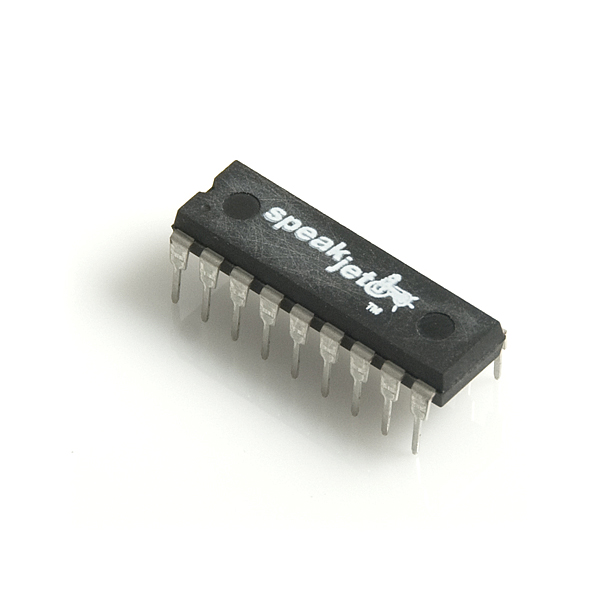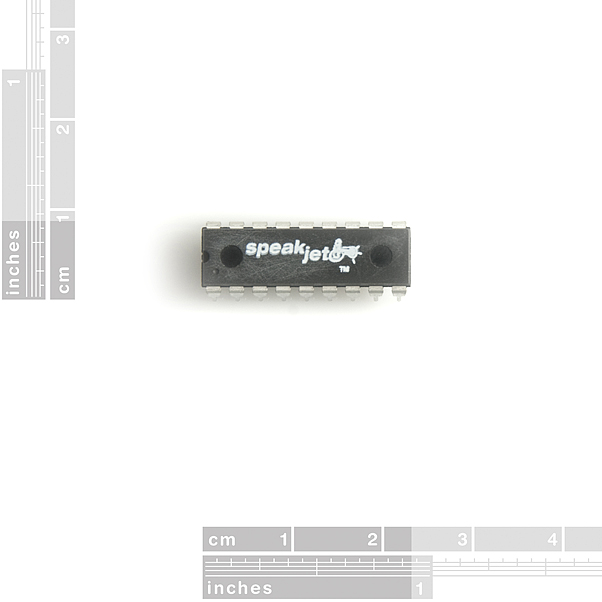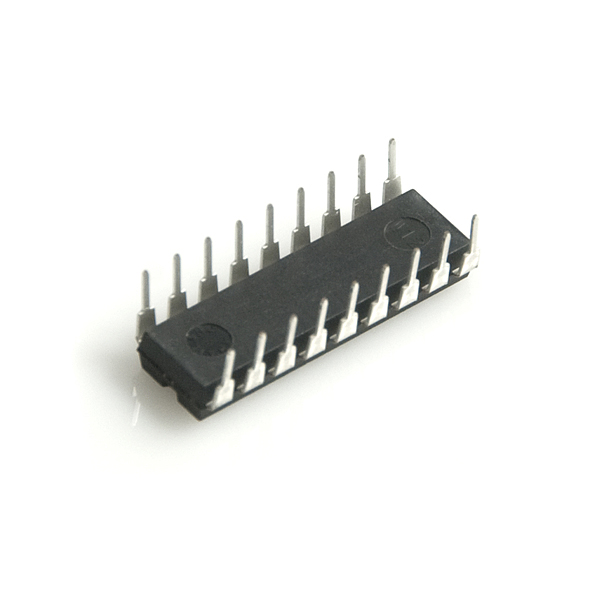SpeakJet
The SpeakJet is a completely self-contained, single-chip voice and complex sound synthesizer. It uses a mathematical sound algorithm to control an internal five channel sound synthesizer to generate on-the-fly, unlimited vocabulary speech synthesis and complex sounds.
The SpeakJet is pre-configured with 72 speech elements (allophones), 43 sound effects, and 12 DTMF Touch Tones. Through the selection of these sounds, and in combination with the control of the pitch, rate, bend, and volume parameters, the user has the ability to produce unlimited phrases and sound effects, with thousands of variations, at any time.
The SpeakJet can be controlled simultaneously by logic changes on any one of its eight Event Input lines, and by a single I/O serial line, allowing for both CPU-controlled and stand-along operations.
- Programmable, 5-channel synthesizer
- Natural phonetic speech synthesis
- DTMF and other sound effects.
- Programmable control of pitch, rate, bend and volume.
- Programmable power – up or reset announcements.
- Multiple modes of operation.
- Simple interface to microcontrollers.
- Simple “Stand Alone” operation.
- Three programmable digital outputs.
- Internal 64 Byte input buffer.
- Internal programmable EEPROM.
- Extremely low power consumption.
- Low pin count.
- Multiple case styles available.
- User's Guide
- SpeakJet Dictionary
- Phrase-A-Lator Demonstration Software
- SpeakJet Homepage
- Listen in MP3 Format as SpeakJet Introduces Itself
SpeakJet Product Help and Resources
Core Skill: Soldering
This skill defines how difficult the soldering is on a particular product. It might be a couple simple solder joints, or require special reflow tools.
Skill Level: Rookie - The number of pins increases, and you will have to determine polarity of components and some of the components might be a bit trickier or close together. You might need solder wick or flux.
See all skill levels
Core Skill: Programming
If a board needs code or communicates somehow, you're going to need to know how to program or interface with it. The programming skill is all about communication and code.
Skill Level: Rookie - You will need a better fundamental understand of what code is, and how it works. You will be using beginner-level software and development tools like Arduino. You will be dealing directly with code, but numerous examples and libraries are available. Sensors or shields will communicate with serial or TTL.
See all skill levels
Core Skill: Electrical Prototyping
If it requires power, you need to know how much, what all the pins do, and how to hook it up. You may need to reference datasheets, schematics, and know the ins and outs of electronics.
Skill Level: Competent - You will be required to reference a datasheet or schematic to know how to use a component. Your knowledge of a datasheet will only require basic features like power requirements, pinouts, or communications type. Also, you may need a power supply that?s greater than 12V or more than 1A worth of current.
See all skill levels
Comments
Looking for answers to technical questions?
We welcome your comments and suggestions below. However, if you are looking for solutions to technical questions please see our Technical Assistance page.
Customer Reviews
3.5 out of 5
Based on 4 ratings:
2 of 2 found this helpful:
really like it
great way to easily add speech and cool sound effects to (arduino) projects. Just wish it was cheaper....
1 of 1 found this helpful:
It is working as intended. This is a good piece. Thank you
5 of 5 found this helpful:
Poor documentation slows development, overpriced
The documentation for this interesting IC badly needs a revision and additional information. Lack of timing diagrams and timing specifications can cause confusion. It took a while before this chip uttered the first word I sent it via a serial connection. (The chip defaults to 9600 bps, so no need to configure it to start.) A list of the factory-set, or default, conditions would help. For that information you must go through a lot of text. The chip responds to what Magnevation calls a Serial Control Protocol, SPC. Descriptions refer to the capability to read and write to and from internal EEPROM. But the chip lacks a serial output, so you cannot read the contents of registers, you can only change them. Strange. The document includes a table, "Subset of SCP Commands," which makes me think other commands exist but remain unlisted or unknown. Perhaps the manufacturer means this subset shows only the commands for this chip.
The Phrase-A-Lator software can help you translate words into the commands to have the chip speak them. A microcontroller (MCU) can easily handle that task. But you need a direct logic-level--NOT RS-232 voltages!--connection between a PC or microcontroller to change some settings. That process can get more involved than you might want. By default the chip says "Ready" whenever it gets power or detects a Reset signal. I find that annoying. A single bit in an EEPROM location would let me disable this "feature," but I don't want to affect the other seven bits. The Phrase-A-Lator software includes a way to do this, but it also writes data to all other registers all in one long transmission! Good grief. I don't want to duplicate that process!
If you really want speech in an application, you might try this chip, but frankly it's overpriced and poorly documented.
1 of 1 found this helpful:
Great addition to my hobby projects.
I found this simple enough to add to my amateur hobby projects. Love the R2D2 like sound effects as well.




I wonder how old this typo ish...
The SpeakJet can be controlled simultaneously by logic changes on any one of its eight Event Input lines, and by a single I/O serial line, allowing for both CPU-controlled and stand-along operations.
"stand-along" in the last line, instead of stand-alone :P
YES! Now I can be rocking with Hawking.
Here is a video link to listen:
http://blog.bricogeek.com/noticias/arduino/speakjet-shield-sintetizador-de-voz-para-arduino/
And there is some sample code for AVR:
http://www.bdmicro.com/code/speakjet/src/speakjet/main.c
Sounds really cool! :)
Thanks for SparkFun, I have invented SpeakJet Parsers as a Rapid Application Development Tool... https://github.com/KuyaMarc/speakjet-parsers
Exterminate!! EXTERMINATE!!!! The Doctor shall be EXTERMINATED!!
I'm sorry, I couldn't resist.
"How about a nice game of CHESS?"
No, global Thermonuclear Warfare
A fun project to play with. I have a video: http://www.youtube.com/watch?v=5xNQAFs6mcI
I used the TTS256 chip along with the speakjet. The TTS256 has some pronunciation "bugs" but you can get by with creative spelling.
i believe you guys forgot to post the link to Magnevations speakjet software (phrase-a-lator).
By the time you've added the text to speech chip it's barely $10 cheaper than the Emic 2. It's smaller, less robot like and has has lots of cool features. Check it out Emic 2
Do the pins RC0 + RC1 offer 4 events each or 4 together ?
Check out my little robot. It can talk and sing using the speakjet chip.
http://www.youtube.com/watch?v=dYWQB12Ibsw
So cool! Thanks for sharing!
I made a cool R2-D2 project with the SpeakJet chip and the SparkFun Mono Audio Amp Breakout. Check it out It's a pretty neat chip.
R2-D2 is cool... but for a real challenge try do C-3P0 (just English, not all 6 million forms of communication)
Ok, I don't get it. This was possible (same quality, same sound library) with the SPO-256 chip that Radio Shack sold over 20 years ago for $29.95. http://www.futurebots.com/spo256.pdf
You'd think there's something better by now? Better sound/voice processor somewhere?
\HEEYLOWWW \WWAXRRLOOD
Is there a library for non-English use?
me want :D
I created a Eagle Library File of the Magnevation SpeakJet and uploaded the file to EagleCadUSA. I'll post the link once it's ready, if anyone would like to add this to their project.
This might be the greatest way ever to ruin a Big Mouth Billy Bass.
i need a help in programming a speakjet with pic16f877a in mikrobasic ,please
Okay. SOMEONE MAKE A MIDI ALLOPHONE MODULE WITH THIS. PLEASE.
Call him Bobby McFerrite.
What does 5 channel synth mean? It can be talking and making sound effects at the same time?
It means it can output 5 different frequencies allowing it to create more life-like sounds.
I composed a blog on using the Speakjet with a PICAXE-18M2 and an I2C temp sensor TMP102 in PICAXE Basic code for another programming example. Less than 40 lines of code made a system that compares the last temperature reading to the current one, and speaks "hotter" or "colder" if it changes a degree or more.
[http://dinsmorerobotlab.blogspot.com/2011/09/hottercolder-talking-temp-sensor.html]
For an essay on connecting one to an Arduino, go to...
http://www.arunet.co.uk/tkboyd/ec/ec1speak.htm
Information on the necessary audio amplifier and encouragement to use the Phrase-a-lator are included.
Okay, I finally put my SpeakJet on the breadboard. Just have to say THIS THING IS AMAZING!! I had no idea how cool it would be. The robot sound effects alone are worth the price ("Is that you R2?") And it was pretty easy to create some new words not included in the standard library. Robot profanity! (Childish, but hilarious). Hey, that might be useful for the Antimov thing, eh? Robot utters a few choice words before self destructing. ;-)
I ordered one of these and instead SFE sent me a 3 to 8 line decoder. Probably just a mixup, but how can this be fixed? It says M74HC238B1 on the back of the chip.
If you haven't already done so, please email customer service at customer service at sparkfun dot com.
Ok, just recieved the chip today. Amazed at the great customer support and shipping speed. Thanks guys!
You're welcome. Sorry for the mix-up.
Just wondering, why does the IC in the picture have scratches on the top? It looks as though it has been used, or scratched by a cat (my cat loves to just chew on diodes and capacitors...)
Mr President, it's probably scratched because it started life as a general-purpose flash-based microcontroller (PIC, AVR, etc.). The SpeakJet people loaded it with their code, removed (scratched off) the chip's original markings, and put their own logo on it. Pretty common occurrence, if you can't afford the lot size it would take to get the base chips without markings on them.
I don't think an AVR or PIC has an internal 5-channel DAC synthesizer or flash memory for that much data
What does "multiple case styles" mean?
This looks AWESOME!! Can't wait to order it!
Multiple case styles probably means that you can get it in a DIP, SMD, or some other package.
I'm not sure but that's the normal definition, but here it is talking about the speakjets capability to speak the same letter or phrase at different pitches or "Case Styles" etc.
Agreed, COOL!
How clear is the speech?
Um.
COOL.